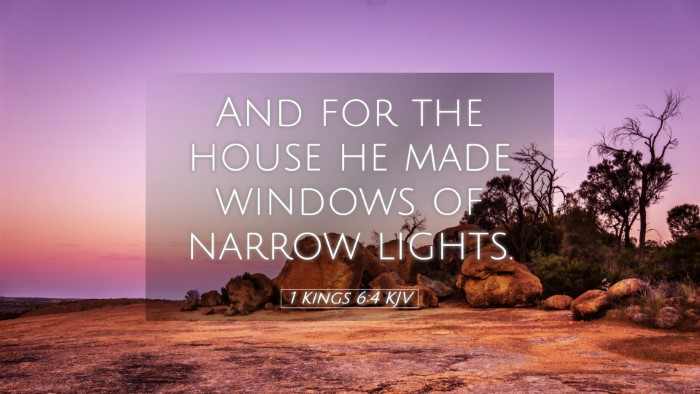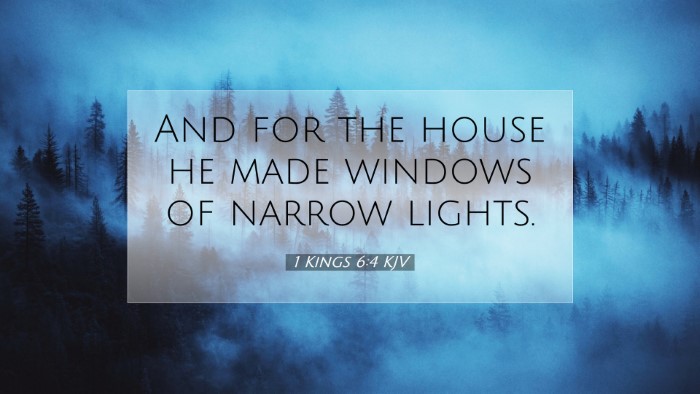Bible Commentary on 1 Kings 6:4
Verse: "And the windows of the temple were narrow within, and broader without." (1 Kings 6:4, KJV)
Introduction
This verse presents a significant architectural feature of Solomon's temple that is rich with theological implications and invites deeper reflection. The narrowness of the windows from the inside contrasted with their broader openings on the outside speaks to various spiritual truths and the broader narrative of the temple as a symbol of God's presence among His people. We will explore insights from notable public domain commentaries, including those by Matthew Henry, Albert Barnes, and Adam Clarke.
The Architectural Significance
In observing the physical structure of the temple through this passage, we find:
- Narrow Windows Inside: This design may suggest a controlled light intake, emphasizing the holiness and sanctity of the interior space reserved for worship.
- Wider Windows Outside: Contrarily, the broader openings to the outside may symbolize the light of God's presence reaching out into the world, inviting the faithful but also confirming the potential of distraction from worldly matters.
Theological Insights
The juxtaposition of the window sizes serves as a metaphor for understanding spiritual truth and divine revelation:
- Spiritual Focus: Matthew Henry notes that the interior of the temple, being narrow, serves to remind worshippers that the path to God requires a focused and intentional approach, distancing oneself from worldly distractions.
- Divine Illumination: Albert Barnes interprets the narrow windows as indicative of how God's light and truth might initially seem limited to those who seek Him diligently. However, it is when one steps outside the confines of self that they can embrace the broader vision of divine purpose.
Practical Application for Today’s Believer
This verse invites reflection on how believers engage with the world:
- Inner Spiritual Life: Much like the temple's narrow windows, a believer's inner life should be cultivated, allowing spiritual truths to be prioritized over societal influences.
- Witness to the World: The external broadness suggests that while we focus on our inward spirituality, we must also allow the light of God's truth to radiate outward, drawing others to His presence.
Insights from Adam Clarke
Clarke offers pertinent observations about the contrast between inner and outer dimensions:
- Symbol of Revelation: He emphasizes that the temple represents God's presence and the narrowness of the windows inwardly indicates the limited human understanding of divine mysteries, yet there exists an invitation to embrace a broader understanding through grace.
- Contrast with the World: Clarke also draws attention to how the design mirrors a contrast between the holy place and the secular world, urging believers to remain vigilant against external distractions that could alter their vision of God.
Conclusion
1 Kings 6:4 serves as a profound reminder of the relationship between the sacred and the secular, the internal spiritual life, and the outward witness. As believers contemplate this architectural feature of Solomon's temple, they are called to reflect on their own lives: Are they cultivating a narrow focus on the holiness of God while ensuring that His light is allowed to shine outward into a waiting world? Such duality invites a deeper understanding of what it means to live as a follower of Christ today.


